The Sean
Cricketer Of The Year
So I did get to do this tonight after all, and so without further ado we enter CW's all time top 20, finishing tonight with the man who achingly just missed out on a hallowed place in your top 10.
20.

Sir Ian Botham | Cricket Players and Officials | Cricinfo.com
Nominated by 47% of voters - highest ranking no.2
Ian Botham played on for too long past his best, he gained weight, lost form and finished his career a pale shadow of the player he'd one been. There, now that we've gotten that out of the way all that is left to do is to celebrate - quite rightly - one of the most explosive, dynamic matchwinners in the history of cricket. Beefy was a one-off, England's miracle man, capable of turning the course of a match in the blink of an eye with a blistering innings, a string of quick wickets or a catch that no one else alive could have even dreamt of taking. Indeed, Botham married great batting and bowling performances together more often than anyone else ever has - he made a century and took a five-wicket haul in the same Test match a ridiculous five times. To put that into context, no one else has ever achieved that feat more than twice. He was the first man to score a century and take ten wickets in a Test, and remains the only one ever to make a ton and take an 8-for in the same Test too.
It would be impossible to speak of Botham without mentioning '81 - has one man ever so singlehandedly (with apologies to Bob Willis) turned a series on its head like he did that summer? The miracle of Headingley would have been enough for most mere mortals to rest on, but the mighty all rounder than produced similar Man of the Match displays in the next two Tests to lead England to an amazing comeback series win, and establish himself as the biggest name in English cricket since at least Compton, possibly since Grace. His charity work and rockstar lifestyle meant he was never out of the headlines, and - now Sir Ian - he can be found giving his always strong opinions as a commentator.
19.
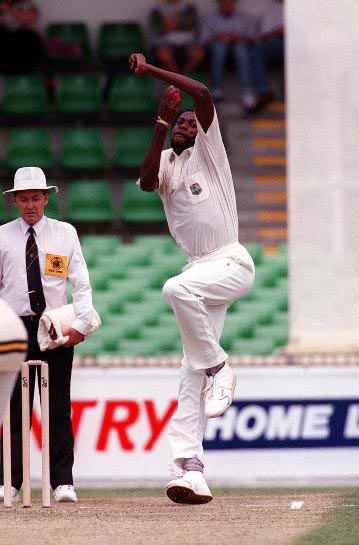
Curtly Ambrose | Cricket Players and Officials | Cricinfo.com
Nominated by 68% of voters - highest ranking no.2
The cricket world was blessed with a host of truly great fast bowlers who reached their prime together in the 1990s. Waqar was the qickest, Donald the smoothest, Wasim the most naturally gifted and Walsh the most durable. But the most consistent, intimidating and - according to most of you - greatest, was Curtly Ambrose. 6 feet 7 inches tall with an intense stare and few words to say to anyone, Ambrose was a batsman's nightmare - he was genuinely fast but had the accuracy and control of a medium pacer and this, combined with the sharp, steepling bounce he generated, could make him virtually unplayable on his day.
Unfortunately for the world's batsman, "his day" seemed to happen just about every time he took the new ball. If Curtly's 405 Test wickets at less than 21 aren't impressive enough, then his economy rate of 2.3 - freakish for a fast bowler - surely seals the deal. In amongst a career full of superb displays, a few stand out: his 6/34 to demolish South Africa when they seemed set for an easy win, his extraordinary spell of 7/1 against Australia which ripped the Aussies to pieces and, well, just about every match he ever played against England - his record against them reads 164 wickets at 18. The Windies would give anything for a Curtly Ambrose right now, but then again so would everyone else...
18.
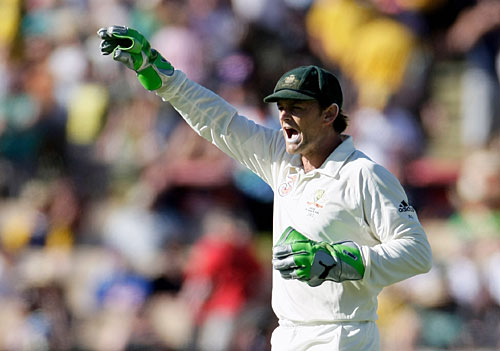
Adam Gilchrist | Cricket Players and Officials | Cricinfo.com
Nominated by 68% of voters - highest ranking no.4
It has been argued that, relative to his role within the team, Adam Gilchrist is the third greatest cricketer of all time - given that he is the third name on the teamsheet for an All Time World XI. He's not quite that high in this particular study, but as the only 'keeper on our list he has cemented his position as the greatest wicketkeeper-batsman in the history of the game. A dashing 81 and five catches first Test was followed by a matchwinning unbeaten 149 in his second, and any doubts about whether he could fill the great Ian Healy's shoes were gone in an instant. That century was the first of seemingly countless match-turning innings played by Gilchrist as he - like Botham two decades before him - proved he was a man for the big occasion. In one-dayers he was equally brilliant, his ability to strike a cricket ball almost defying belief at times as he tore attacks apart from the top of the order. Gilchrist was actually voted Australia's greatest ever one-day cricketer, and his career in the short form of the game culminated fittingly in the 2007 World Cup final with an astonishing 149* off just 104 balls to lead Australia to victory against Sri Lanka.
Such was his magnificence with the bat that it was often overlooked that Gilchrist worked exceptionally hard at his 'keeping and developed from a good 'keeper into an outstanding one, finishing his career with more than 400 dismissals in both Tests and ODIs and gaining a reputation as one of the very best in the business. Best of all however, Gilly played his cricket in a sporting manner with a smile on his face, and you'd struggle to find anyone in the sport with a bad word to say about him. Living proof that nice guys really can finish first after all.
17.
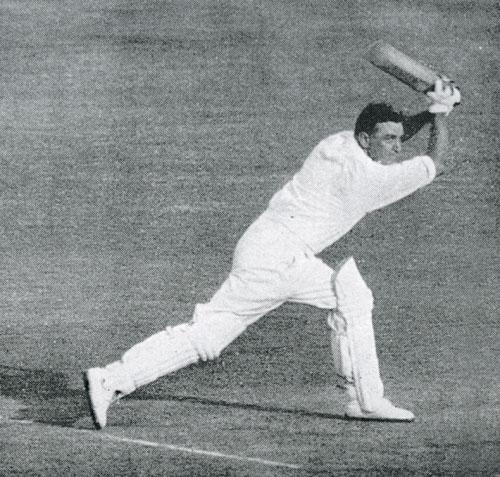
Wally Hammond | Cricket Players and Officials | Cricinfo.com
Nominated by 66% of voters - highest ranking no.3
Wally Hammond is unquestionably a pure, bona fide cricketing immortal. One of the very greatest batsmen of all time, he may also be the finest ever first-slip as well, and was a good enough fast-medium bowler to take 732 First Class wickets, 83 of them in Tests despite never truly taking his bowling seriously. He had a regal air about him, and Tom Graveney once wrote that it was worth the price of admission purely to watch Hammond walk out to bat. That walk was just the beginning of the glory however, as it was invariably followed by Hammond majestically putting to the sword whichever attack he was faced with. The first man (and still one of only two) to score 900 runs in a series, Hammond scored more than 7,000 Test runs and averaged over 58 - a figure which would have been even higher but for his ill-fated tour of Australia at the end of his career. He converted 7 of his 22 Test centuries into double-tons, and his 336* against New Zealand in 1933 was (retrospectively) the world record Test score until broken by Hutton.
For all his regal style and incredible cricketing achievements, Hammond could be a difficult character personally and rarely had close friendships with team mates or opponents - indeed, Wisden refers to his "olympian aloofness" which seems to be a very polite way of say that he was moody. After cricket, he retired to South Africa but found little happiness and died a poor man. It was not the way one of cricket's true immortals deserved to go out, but thankfully his reputation remains as brightly shining as ever.
16.
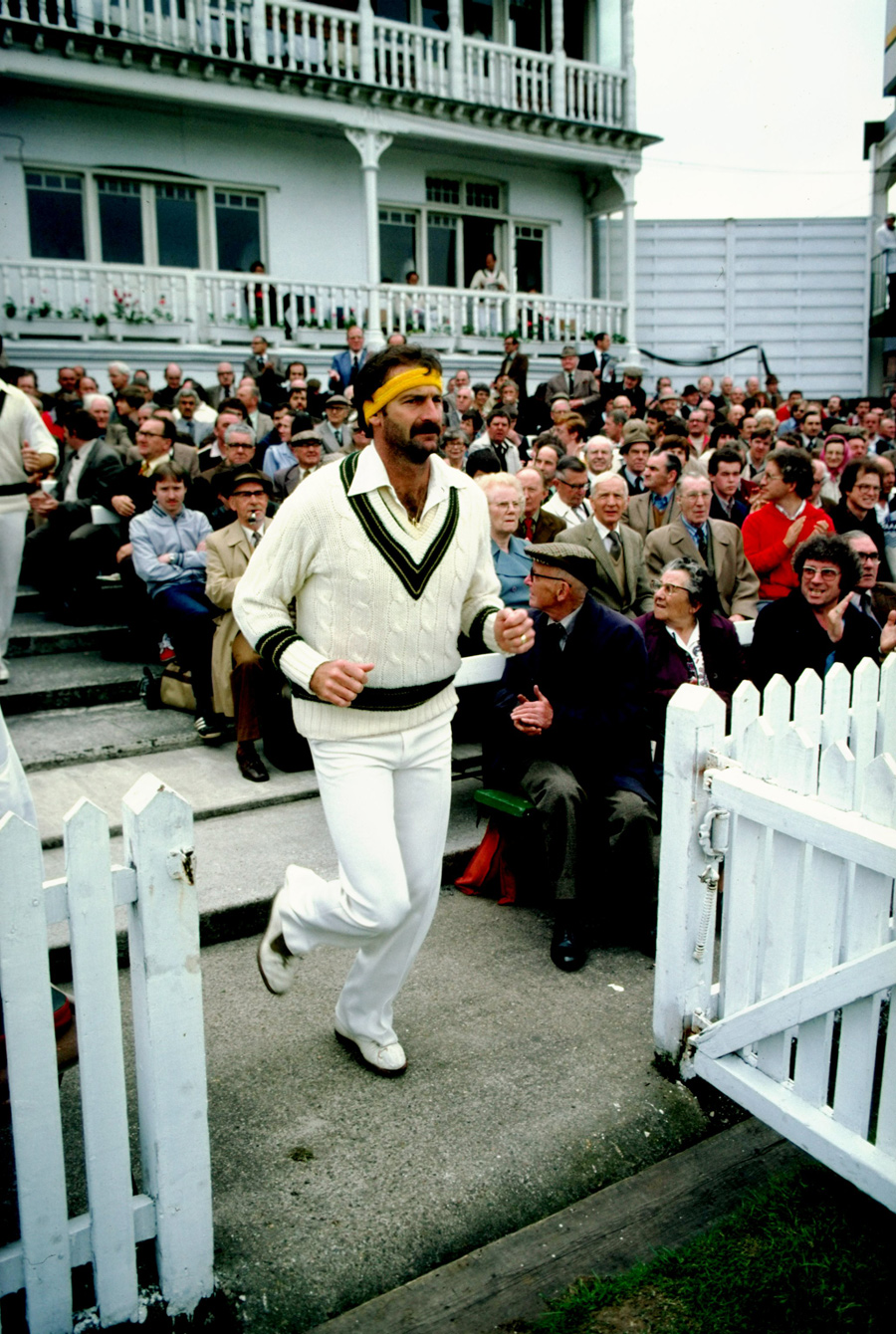
Dennis Lillee | Cricket Players and Officials | Cricinfo.com
Nominated by 66% of voters - highest ranking no.4
A great sea-change swept across cricket in the 1970s. Colour television and extra sponsorship meant that players were being promoted as never before, and after years of defensive cricket pitches were becoming more bowler-friendly and cricket was becoming more exciting. For the first time in a long time bowlers - particularly charismatic fast bowlers - were becoming the stars of the show, and the undisputed leader of the pack was DK Lillee. Lillee burst onto the Australian domestic scene like a bolt of lightning and was called into the Australian Test side at just 21, taking five wickets in his first match. There followed a phenomenal 8/29 for Australia against the Rest of the World and a then-record 31 wickets on his first Ashes tour in 1972, and it seemed that the cricketing world was at the young paceman's feet. However, disaster struck and Lillee broke down in the Caribbean with a stress fracture and it was feared he may never bowl again.
Two years later, however, Lillee returned and for all his achievements it may be that comeback from a potentially crippling injury was his greatest of all. He took his second chance with both hands and the next decade was triumph after triumph for Lillee as he claimed his place as arguably the greatest fast bowler of all time. A two-year interlude as one of the biggest stars of World Series Cricket only enhanced his reputation, and as his pace declined he more than compensated with intelligence, cunning and variety. A crowd hero in Australia the likes of which had not been seen for decades, Lillee was a man of the people and he crowned his career in the most glorious fashion by dismissing Larry Gomes to break Lance Gibbs' world Test record in the Boxing Day Test of 1981. He finished that innings with seven wickets and led Australia to an upset win over the all-conquering Windies. Since his retirement in 1984, Lillee has been heavily involved in coaching and is always on the lookout for the next great fast bowling prospect that he can assist with his knowledge and experience. They could not be in better hands.
15.

Brian Lara | Cricket Players and Officials | Cricinfo.com
Nominated by 79% of voters - highest ranking no.2
The only batsman to score a Test quadruple century, the only batsman to score a First-Class quintuple century, the only batsman to regain the world Test record score and one of only two batsmen to have held the world Test and First-Class record scores simultaneously, it's probably fair to say that Brian Charles Lara - the Prince of Port-of-Spain - could bat a bit. A gloriously attacking player with a thrilling style, his capacity to rack up truly massive scores was unparallelled by any other player of his generation. Such runmaking genius was first announced to the world with his epic 277 at Sydney in 1993 and carried on with such performances over the ensuing few years that he actually invited comparisons with Bradman - the zenith of which were the twin records of 375 and 501* in the space of two months in 1994. As the decade wore on, his consistency faded and - as the keeper of the flame during a period where the West Indies declined from all-conquering to also-rans - it appeared he was growing exceedingly frustrated with both his team and himself.
Lara's renaissance, therefore, was truly special and something to be celebrated by everyone within the game. He single-handedly turned around a series against Australia in 1999 with two of the finest innings ever played, later against Sri Lanka scored 688 runs in just three Tests for a losing cause - accounting for nearly half his entire team's runs for the series - followed of course by that monumental 400* against England. Lara overtook Allan Border's record of 11,174 runs and finished with a mark just short of 12,000 before he retired, signing off in his last series with an 8th Test double century. Disputes with the WICB forced his retirement, Lara's parting from the game in 2007 as dramatic as his strokemaking had been for the previous 15 years.
14.
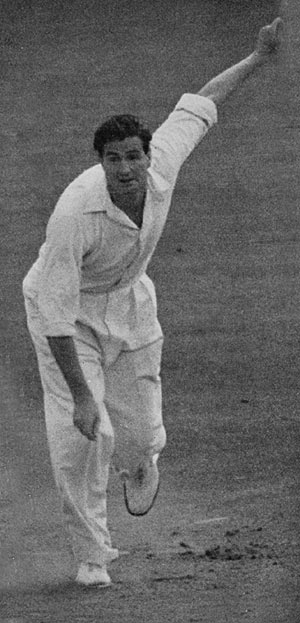
Keith Miller | Cricket Players and Officials | Cricinfo.com
Nominated by 74% of voters - highest ranking no.3
"I'll tell you what pressure is son. Pressure is a Messerschmitt up your arse - playing cricket is not." With these immortal words Keith Ross Miller summed up perfectly what he was all about. Australia's greatest ever all-round cricketer, and one of the very best produced by any country in the history of the game, Miller was a dashing and debonair genius who achieved that oh-so-rare feat of being a sportsman who was as popular with the fairer *** as he was with the blokes. A fighter-bomber pilot during WWII, "Nugget" made his name as the darling of the Victory Tests in 1945 and in the same summer for a Dominions XI he made 185 against England at Lord's, an innings which included seven sixes, and remains to this day one of the greatest batting exhibitions ever given at the home of cricket.
The war meant that Miller played just one Test before the age of 27, but he quickly made up for lost time with a superb first Ashes series against England in 1946/47 and playing a key role in the legendary "Invincibles" of 1948. With Bradman's retirement, he became the biggest star in Australian cricket and continued his brilliant displays into the early 1950s. Miller was never inspired by unequal contests and took no pleasure in bashing minnows, but invariably saved his best for when it mattered most - it is surely no coincidence that all of his Test centuries and all but one of his Test 5-wicket hauls came against either England or the West Indies, the two strongest opposition powers of the time. Such were his performances against the touring West Indians in 1951/52 that they inspired John Goddard's famous comment "give us Miller and we'll beat the world." Notorious for his rogue charm and daring, Miller mixed with aristocracy and (allegedly) slept with royalty, all the while managing to turn in amazing performance after amazing performance on just a couple of hours sleep. He died within hours of Christopher Reeve, and more than one media outlet commented that the world had lost two supermen in one day.
13.
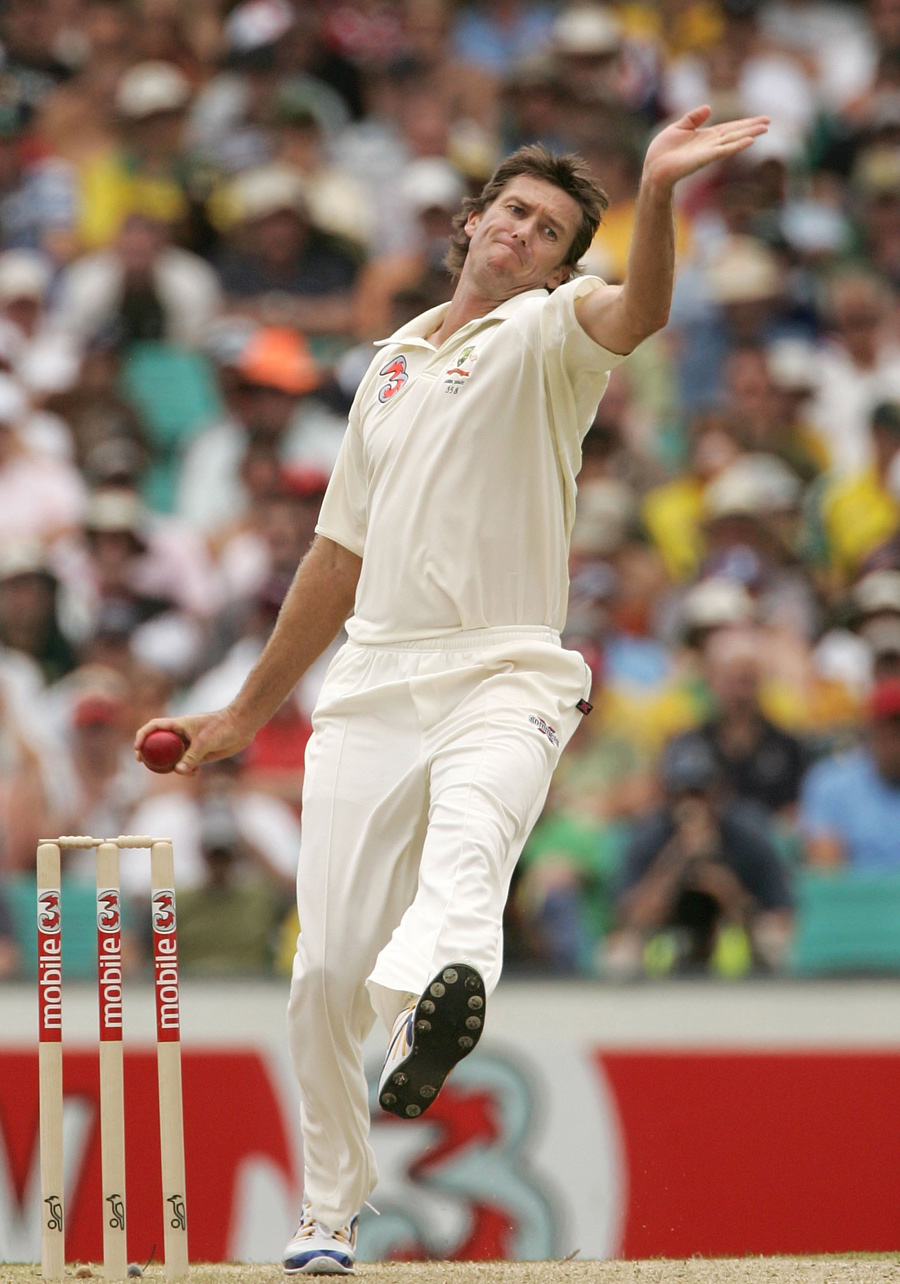
Glenn McGrath | Cricket Players and Officials | Cricinfo.com
Nominated by 79% of voters - highest ranking no.2
Glenn McGrath wasn't especially quick, he didn't move the ball a great deal in the air or off the seam, and he didn't radiate any particular menace or intensity. What he did do was take wickets. Followed by more wickets. And not just any wickets either - but the big ones, the oppositions top guns, the men his adversaries were relying on to lead them to victory. There can be few bowlers who have ever deliberately set themselves to always target the very best batsmen on the opposing team, and fewer still who had the remarkable ability to pull it off as often as McGrath did. Shane Warne has been justifiably lauded for his wicket-taking feats, but he was often finishing a job that had been started - and pushes irreversibly forward - by McGrath. A tall beanpole of a bowler who made his debut in 1993, it was as leader of Australia's attack in the historic win in the Caribbean in 1995 that truly established him as his country's spearhead.
Two of the four best Test-innings bowling figures by an Australian belong to McGrath, while his 563 Test wickets are a record for a fast bowler. What was truly remarkable about the man they called Pidgeon was that as the decade turned, pitches got flatter and runscoring reached new levels, he actually got even better. From the turn of the decade until his retirement, in an era where batting averages skyrocketed and bowling figures worldwide took a pounding, McGrath took just short of 300 Test wickets at an average of just 20 - numbers that are scarcely believable. At the end of it all, he finished his international career with a double triumph - first helping Australia to a 5-0 Ashes win and then bowing out with a record 26 wickets and the Man of the Tournament award as Australia won the World Cup. Going out on the highest of highs indeed.
12.

Muttiah Muralitharan | Cricket Players and Officials | Cricinfo.com
Nominated by 84% of voters - highest ranking no.3
Muttiah Muralitharan is quite simply the greatest wicket-taking phenomenon of the past 100 years, and very possibly of all time. So many records have fallen to this friendly and unassuming Sri Lankan genius that we tend to take them for granted - the all-time leading wicket-taker in both Tests and One Day Internationals with an extraordinary combined total of more than 1,300, 66 Test five-wicket hauls, an astonishing 22 Tests in which he has taken 10 wickets or more, one of only two men to have twice taken 9 wickets in a Test innings and joint holder of the record for the most Man of the Match awards in Test cricket. It can be dangerous to get too obsessed with the numbers when talking about any cricketer, but when the numbers are so incredible it is difficult to avoid talking about them.
Equally, it is difficult to avoid talking about Murali without addressing the controversies that have plagued him throughout his career with regard to his unusual bowling action. Called a "chucker" early in his career not just by fans and spectators but, infamously, by more than one umpire as well, Murali would not have been judged for packing it in and leaving cricket. However, such is not the nature of the man and with two particularly powerful allies - his unfailingly supportive captain Arjuna Ranatunga and body motion technology which displayed to the world the legality of his action under the new ICC limits - he came back stronger and more brilliant than ever. Murali overtook Courtney Walsh to become Test cricket's leading wicket taker in 2004 and then, after losing it to Shane Warne, took it back again in 2007. He completed the Test/ODI double by overtaking Wasim Akram in 2009, and by the time he retires - the current rumours say 2011 - he may have set marks that will never be beaten.
11.
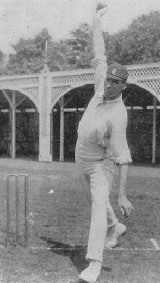
Sydney Barnes | Cricket Players and Officials | Cricinfo.com
Nominated by 82% of voters - highest ranking no.3
If Murali isn't cricket's greatest ever wicket-taking machine then surely Sydney Francis Barnes is. Universally acknowledged as the outstanding bowler of his generation, most of those who saw him in action had no hesitation in going further claiming him to be the very finest bowler of all time. A fast-medium bowler who seems from accounts to have been able to swing, seam or spin the ball with equal skill, Barnes was exceptionally dangerous even on good wickets and all-but unplayable on bad ones. Archie MacLaren famously selected Barnes to tour Australia on the strength of watching him in a net session, but 19 wickets in his first two Tests soon displayed that such faith him was not misplaced. It was the beginning of a remarkable Test career that yielded 189 wickets from just 27 matches - an average of 7 wickets per Test.
How many more wickets might there have been, though, had Barnes been rather more - how to put this - sociable? A notoriously bristling, difficult man, he infuriated team mates and opponents alike - when a ship containing the England team was caught in rough weather, skipper MacLaren famously remarked "well if we go down at least we'll take that beggar Barnes with us." Partly because of his personality, Barnes did not play Test cricket at all between 1902 and 1907, not even playing the County game but preferring to acquire and untouchable record in League cricket. It is something to contemplate how the famous 1902 series might have unfolded had England's best bowler actually been selected, but Barnes made up for it by dominating three series toward the end of his career, and taking 122 wickets in his last 15 Tests. When told that a certain Australian batsman considered O'Reilly to be the greater bowler because of his ability to bowl the googly, Barnes replied mischievously "True, I didn't bowl the googly...I never needed to."
So that, dear friends, is where we end things for tonight - what Barney would say about missing the top 10 by a single spot one shudders to think, but the members of CW have voted in ten players ahead of him, and from this point on they will be revealed one by one. Stay tuned...
20.

Sir Ian Botham | Cricket Players and Officials | Cricinfo.com
Nominated by 47% of voters - highest ranking no.2
Ian Botham played on for too long past his best, he gained weight, lost form and finished his career a pale shadow of the player he'd one been. There, now that we've gotten that out of the way all that is left to do is to celebrate - quite rightly - one of the most explosive, dynamic matchwinners in the history of cricket. Beefy was a one-off, England's miracle man, capable of turning the course of a match in the blink of an eye with a blistering innings, a string of quick wickets or a catch that no one else alive could have even dreamt of taking. Indeed, Botham married great batting and bowling performances together more often than anyone else ever has - he made a century and took a five-wicket haul in the same Test match a ridiculous five times. To put that into context, no one else has ever achieved that feat more than twice. He was the first man to score a century and take ten wickets in a Test, and remains the only one ever to make a ton and take an 8-for in the same Test too.
It would be impossible to speak of Botham without mentioning '81 - has one man ever so singlehandedly (with apologies to Bob Willis) turned a series on its head like he did that summer? The miracle of Headingley would have been enough for most mere mortals to rest on, but the mighty all rounder than produced similar Man of the Match displays in the next two Tests to lead England to an amazing comeback series win, and establish himself as the biggest name in English cricket since at least Compton, possibly since Grace. His charity work and rockstar lifestyle meant he was never out of the headlines, and - now Sir Ian - he can be found giving his always strong opinions as a commentator.
19.

Curtly Ambrose | Cricket Players and Officials | Cricinfo.com
Nominated by 68% of voters - highest ranking no.2
The cricket world was blessed with a host of truly great fast bowlers who reached their prime together in the 1990s. Waqar was the qickest, Donald the smoothest, Wasim the most naturally gifted and Walsh the most durable. But the most consistent, intimidating and - according to most of you - greatest, was Curtly Ambrose. 6 feet 7 inches tall with an intense stare and few words to say to anyone, Ambrose was a batsman's nightmare - he was genuinely fast but had the accuracy and control of a medium pacer and this, combined with the sharp, steepling bounce he generated, could make him virtually unplayable on his day.
Unfortunately for the world's batsman, "his day" seemed to happen just about every time he took the new ball. If Curtly's 405 Test wickets at less than 21 aren't impressive enough, then his economy rate of 2.3 - freakish for a fast bowler - surely seals the deal. In amongst a career full of superb displays, a few stand out: his 6/34 to demolish South Africa when they seemed set for an easy win, his extraordinary spell of 7/1 against Australia which ripped the Aussies to pieces and, well, just about every match he ever played against England - his record against them reads 164 wickets at 18. The Windies would give anything for a Curtly Ambrose right now, but then again so would everyone else...
18.

Adam Gilchrist | Cricket Players and Officials | Cricinfo.com
Nominated by 68% of voters - highest ranking no.4
It has been argued that, relative to his role within the team, Adam Gilchrist is the third greatest cricketer of all time - given that he is the third name on the teamsheet for an All Time World XI. He's not quite that high in this particular study, but as the only 'keeper on our list he has cemented his position as the greatest wicketkeeper-batsman in the history of the game. A dashing 81 and five catches first Test was followed by a matchwinning unbeaten 149 in his second, and any doubts about whether he could fill the great Ian Healy's shoes were gone in an instant. That century was the first of seemingly countless match-turning innings played by Gilchrist as he - like Botham two decades before him - proved he was a man for the big occasion. In one-dayers he was equally brilliant, his ability to strike a cricket ball almost defying belief at times as he tore attacks apart from the top of the order. Gilchrist was actually voted Australia's greatest ever one-day cricketer, and his career in the short form of the game culminated fittingly in the 2007 World Cup final with an astonishing 149* off just 104 balls to lead Australia to victory against Sri Lanka.
Such was his magnificence with the bat that it was often overlooked that Gilchrist worked exceptionally hard at his 'keeping and developed from a good 'keeper into an outstanding one, finishing his career with more than 400 dismissals in both Tests and ODIs and gaining a reputation as one of the very best in the business. Best of all however, Gilly played his cricket in a sporting manner with a smile on his face, and you'd struggle to find anyone in the sport with a bad word to say about him. Living proof that nice guys really can finish first after all.
17.

Wally Hammond | Cricket Players and Officials | Cricinfo.com
Nominated by 66% of voters - highest ranking no.3
Wally Hammond is unquestionably a pure, bona fide cricketing immortal. One of the very greatest batsmen of all time, he may also be the finest ever first-slip as well, and was a good enough fast-medium bowler to take 732 First Class wickets, 83 of them in Tests despite never truly taking his bowling seriously. He had a regal air about him, and Tom Graveney once wrote that it was worth the price of admission purely to watch Hammond walk out to bat. That walk was just the beginning of the glory however, as it was invariably followed by Hammond majestically putting to the sword whichever attack he was faced with. The first man (and still one of only two) to score 900 runs in a series, Hammond scored more than 7,000 Test runs and averaged over 58 - a figure which would have been even higher but for his ill-fated tour of Australia at the end of his career. He converted 7 of his 22 Test centuries into double-tons, and his 336* against New Zealand in 1933 was (retrospectively) the world record Test score until broken by Hutton.
For all his regal style and incredible cricketing achievements, Hammond could be a difficult character personally and rarely had close friendships with team mates or opponents - indeed, Wisden refers to his "olympian aloofness" which seems to be a very polite way of say that he was moody. After cricket, he retired to South Africa but found little happiness and died a poor man. It was not the way one of cricket's true immortals deserved to go out, but thankfully his reputation remains as brightly shining as ever.
16.

Dennis Lillee | Cricket Players and Officials | Cricinfo.com
Nominated by 66% of voters - highest ranking no.4
A great sea-change swept across cricket in the 1970s. Colour television and extra sponsorship meant that players were being promoted as never before, and after years of defensive cricket pitches were becoming more bowler-friendly and cricket was becoming more exciting. For the first time in a long time bowlers - particularly charismatic fast bowlers - were becoming the stars of the show, and the undisputed leader of the pack was DK Lillee. Lillee burst onto the Australian domestic scene like a bolt of lightning and was called into the Australian Test side at just 21, taking five wickets in his first match. There followed a phenomenal 8/29 for Australia against the Rest of the World and a then-record 31 wickets on his first Ashes tour in 1972, and it seemed that the cricketing world was at the young paceman's feet. However, disaster struck and Lillee broke down in the Caribbean with a stress fracture and it was feared he may never bowl again.
Two years later, however, Lillee returned and for all his achievements it may be that comeback from a potentially crippling injury was his greatest of all. He took his second chance with both hands and the next decade was triumph after triumph for Lillee as he claimed his place as arguably the greatest fast bowler of all time. A two-year interlude as one of the biggest stars of World Series Cricket only enhanced his reputation, and as his pace declined he more than compensated with intelligence, cunning and variety. A crowd hero in Australia the likes of which had not been seen for decades, Lillee was a man of the people and he crowned his career in the most glorious fashion by dismissing Larry Gomes to break Lance Gibbs' world Test record in the Boxing Day Test of 1981. He finished that innings with seven wickets and led Australia to an upset win over the all-conquering Windies. Since his retirement in 1984, Lillee has been heavily involved in coaching and is always on the lookout for the next great fast bowling prospect that he can assist with his knowledge and experience. They could not be in better hands.
15.

Brian Lara | Cricket Players and Officials | Cricinfo.com
Nominated by 79% of voters - highest ranking no.2
The only batsman to score a Test quadruple century, the only batsman to score a First-Class quintuple century, the only batsman to regain the world Test record score and one of only two batsmen to have held the world Test and First-Class record scores simultaneously, it's probably fair to say that Brian Charles Lara - the Prince of Port-of-Spain - could bat a bit. A gloriously attacking player with a thrilling style, his capacity to rack up truly massive scores was unparallelled by any other player of his generation. Such runmaking genius was first announced to the world with his epic 277 at Sydney in 1993 and carried on with such performances over the ensuing few years that he actually invited comparisons with Bradman - the zenith of which were the twin records of 375 and 501* in the space of two months in 1994. As the decade wore on, his consistency faded and - as the keeper of the flame during a period where the West Indies declined from all-conquering to also-rans - it appeared he was growing exceedingly frustrated with both his team and himself.
Lara's renaissance, therefore, was truly special and something to be celebrated by everyone within the game. He single-handedly turned around a series against Australia in 1999 with two of the finest innings ever played, later against Sri Lanka scored 688 runs in just three Tests for a losing cause - accounting for nearly half his entire team's runs for the series - followed of course by that monumental 400* against England. Lara overtook Allan Border's record of 11,174 runs and finished with a mark just short of 12,000 before he retired, signing off in his last series with an 8th Test double century. Disputes with the WICB forced his retirement, Lara's parting from the game in 2007 as dramatic as his strokemaking had been for the previous 15 years.
14.

Keith Miller | Cricket Players and Officials | Cricinfo.com
Nominated by 74% of voters - highest ranking no.3
"I'll tell you what pressure is son. Pressure is a Messerschmitt up your arse - playing cricket is not." With these immortal words Keith Ross Miller summed up perfectly what he was all about. Australia's greatest ever all-round cricketer, and one of the very best produced by any country in the history of the game, Miller was a dashing and debonair genius who achieved that oh-so-rare feat of being a sportsman who was as popular with the fairer *** as he was with the blokes. A fighter-bomber pilot during WWII, "Nugget" made his name as the darling of the Victory Tests in 1945 and in the same summer for a Dominions XI he made 185 against England at Lord's, an innings which included seven sixes, and remains to this day one of the greatest batting exhibitions ever given at the home of cricket.
The war meant that Miller played just one Test before the age of 27, but he quickly made up for lost time with a superb first Ashes series against England in 1946/47 and playing a key role in the legendary "Invincibles" of 1948. With Bradman's retirement, he became the biggest star in Australian cricket and continued his brilliant displays into the early 1950s. Miller was never inspired by unequal contests and took no pleasure in bashing minnows, but invariably saved his best for when it mattered most - it is surely no coincidence that all of his Test centuries and all but one of his Test 5-wicket hauls came against either England or the West Indies, the two strongest opposition powers of the time. Such were his performances against the touring West Indians in 1951/52 that they inspired John Goddard's famous comment "give us Miller and we'll beat the world." Notorious for his rogue charm and daring, Miller mixed with aristocracy and (allegedly) slept with royalty, all the while managing to turn in amazing performance after amazing performance on just a couple of hours sleep. He died within hours of Christopher Reeve, and more than one media outlet commented that the world had lost two supermen in one day.
13.

Glenn McGrath | Cricket Players and Officials | Cricinfo.com
Nominated by 79% of voters - highest ranking no.2
Glenn McGrath wasn't especially quick, he didn't move the ball a great deal in the air or off the seam, and he didn't radiate any particular menace or intensity. What he did do was take wickets. Followed by more wickets. And not just any wickets either - but the big ones, the oppositions top guns, the men his adversaries were relying on to lead them to victory. There can be few bowlers who have ever deliberately set themselves to always target the very best batsmen on the opposing team, and fewer still who had the remarkable ability to pull it off as often as McGrath did. Shane Warne has been justifiably lauded for his wicket-taking feats, but he was often finishing a job that had been started - and pushes irreversibly forward - by McGrath. A tall beanpole of a bowler who made his debut in 1993, it was as leader of Australia's attack in the historic win in the Caribbean in 1995 that truly established him as his country's spearhead.
Two of the four best Test-innings bowling figures by an Australian belong to McGrath, while his 563 Test wickets are a record for a fast bowler. What was truly remarkable about the man they called Pidgeon was that as the decade turned, pitches got flatter and runscoring reached new levels, he actually got even better. From the turn of the decade until his retirement, in an era where batting averages skyrocketed and bowling figures worldwide took a pounding, McGrath took just short of 300 Test wickets at an average of just 20 - numbers that are scarcely believable. At the end of it all, he finished his international career with a double triumph - first helping Australia to a 5-0 Ashes win and then bowing out with a record 26 wickets and the Man of the Tournament award as Australia won the World Cup. Going out on the highest of highs indeed.
12.

Muttiah Muralitharan | Cricket Players and Officials | Cricinfo.com
Nominated by 84% of voters - highest ranking no.3
Muttiah Muralitharan is quite simply the greatest wicket-taking phenomenon of the past 100 years, and very possibly of all time. So many records have fallen to this friendly and unassuming Sri Lankan genius that we tend to take them for granted - the all-time leading wicket-taker in both Tests and One Day Internationals with an extraordinary combined total of more than 1,300, 66 Test five-wicket hauls, an astonishing 22 Tests in which he has taken 10 wickets or more, one of only two men to have twice taken 9 wickets in a Test innings and joint holder of the record for the most Man of the Match awards in Test cricket. It can be dangerous to get too obsessed with the numbers when talking about any cricketer, but when the numbers are so incredible it is difficult to avoid talking about them.
Equally, it is difficult to avoid talking about Murali without addressing the controversies that have plagued him throughout his career with regard to his unusual bowling action. Called a "chucker" early in his career not just by fans and spectators but, infamously, by more than one umpire as well, Murali would not have been judged for packing it in and leaving cricket. However, such is not the nature of the man and with two particularly powerful allies - his unfailingly supportive captain Arjuna Ranatunga and body motion technology which displayed to the world the legality of his action under the new ICC limits - he came back stronger and more brilliant than ever. Murali overtook Courtney Walsh to become Test cricket's leading wicket taker in 2004 and then, after losing it to Shane Warne, took it back again in 2007. He completed the Test/ODI double by overtaking Wasim Akram in 2009, and by the time he retires - the current rumours say 2011 - he may have set marks that will never be beaten.
11.

Sydney Barnes | Cricket Players and Officials | Cricinfo.com
Nominated by 82% of voters - highest ranking no.3
If Murali isn't cricket's greatest ever wicket-taking machine then surely Sydney Francis Barnes is. Universally acknowledged as the outstanding bowler of his generation, most of those who saw him in action had no hesitation in going further claiming him to be the very finest bowler of all time. A fast-medium bowler who seems from accounts to have been able to swing, seam or spin the ball with equal skill, Barnes was exceptionally dangerous even on good wickets and all-but unplayable on bad ones. Archie MacLaren famously selected Barnes to tour Australia on the strength of watching him in a net session, but 19 wickets in his first two Tests soon displayed that such faith him was not misplaced. It was the beginning of a remarkable Test career that yielded 189 wickets from just 27 matches - an average of 7 wickets per Test.
How many more wickets might there have been, though, had Barnes been rather more - how to put this - sociable? A notoriously bristling, difficult man, he infuriated team mates and opponents alike - when a ship containing the England team was caught in rough weather, skipper MacLaren famously remarked "well if we go down at least we'll take that beggar Barnes with us." Partly because of his personality, Barnes did not play Test cricket at all between 1902 and 1907, not even playing the County game but preferring to acquire and untouchable record in League cricket. It is something to contemplate how the famous 1902 series might have unfolded had England's best bowler actually been selected, but Barnes made up for it by dominating three series toward the end of his career, and taking 122 wickets in his last 15 Tests. When told that a certain Australian batsman considered O'Reilly to be the greater bowler because of his ability to bowl the googly, Barnes replied mischievously "True, I didn't bowl the googly...I never needed to."
So that, dear friends, is where we end things for tonight - what Barney would say about missing the top 10 by a single spot one shudders to think, but the members of CW have voted in ten players ahead of him, and from this point on they will be revealed one by one. Stay tuned...
Last edited by a moderator:


